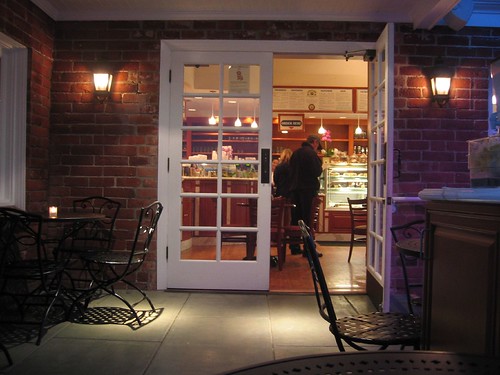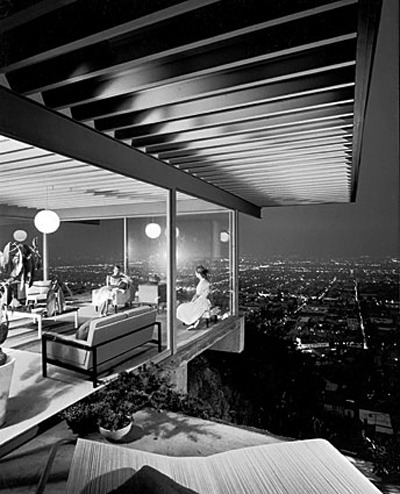 FOUR LEVELS INTO MY HEART
FOUR LEVELS INTO MY HEARTThe four level interchange immediately annoys me.
It irritates me that I have to look at it via aerial view, because I’ve sat in it first handedly. My grandma and her friends refer to it as the “four letter” interchange, but this is what Los Angeles traffic does to some people. It drives elderly women to use four letter words to describe their roadways. When I think about what I’ve learned so far in this course, about how freeways created pockets of living spaces and how they allowed us to only come into contact with those we wanted, I begin to see that the 101 and 110 coming to a head showcases this beautifully. This is a beauty that can only be described with concrete and polluted inhalation. Literally people coming from all directions, north, south, east, and west, are forces to sit in traffic next to one another and absorb each other’s company, even if it is from the comfort of your own Jetta. And what happens when we allow these people to “mingle” on the grid-locked freeways? They brandish weapons over lane-changes and scream inexcusable phrases that force the blood in their carotid arteries to nearly burst. We must really love our neighbors.
It is so easy for me to quickly be harsh on my fellow Angelenos. I describe them as brutish savages that are willing to fight for a stop in the carpool lane. But I must acknowledge that I am not above them. Allow us to remember my initial reaction to the picture: annoyance and irritation. Maybe I should work on my own anger issues, but until then I will continue to put on my blinker a mile and a half before I actually need to get over in order to ensure I make my exit. Hand gestures and honked horns aside, the sweeping lanes of infrastructure could be incredibly calming to the right person. I guess I’m just not that right person today
-- Hailey Hannan
FOUR-LEVEL INTERCHANGEIn the center of the urban jungle that is downtown LA, the 101 and the 110 freeways flow into each other like colliding concrete rivers. Horns and sirens make up the music of the four-level interchange as millions of commuters chug their way through the clutter of the crowded lanes. BMWs and Mercedes mix with old VW buses and big rigs, showing the true diversity of the city. In a city that is so spread out, this is the one place all Angelenos are forced to come together. Though everyone is heading off to their own corner of the city, for these few hours in the morning and afternoon, everyone from all walks of life gathers on these cement pathways.
For some, the highways provide escape—a passageway to another alcove of this amazingly diverse city. Hop on the 110 to travel downtown to the ultra-urban LA Live center. Take the Marina freeway down into Santa Monica or Venice and stroll along the boardwalk. Cruise down the 101 to take a tour of the film studios in Hollywood. No matter where you are in the city, entertainment is just a car ride away.
For most however, the highway system is a nuisance—an eternal headache in an otherwise ideal metropolis. Hours upon hours are spent with a foot on the break, banging on the steering wheel, fuming in an unmovable pod of frustration. Because of the densely packed roadways, appointments are missed, plans are canceled, and people are left waiting. “Traffic” is not an inconvenience, but rather a fact of like in LA.
-- Megan McMurtrey
PICTUREEvery level represents different ideas, mentalities, life styles and values. A four-level freeway doesn’t need an explanation because it speaks so loudly on it’s own. Yet once zoomed in, all those cars on the freeway represent different people who are after different things. Driving east a mother going to work, driving west a student rushing to get to class on time, driving north an explorer wondering where the freeway leads, driving south a human being living life. What’s interesting is not the difference in their agenda, but how they all use the same freeway to take them where they want to go. They are all different people but have found a way to “share” the freeway, share LA.
The four-level freeway in Downtown Los Angeles represents how residents of LA are able to work together, yet be after completely different things. The freeway is a visual of how LA is separated, as each level represents a different way, different lifestyle, but they are all LA residents. They all live in LA and although most may complain about the traffic going on, they don’t leave LA. The freeway represents the chaotic elements of the city, since there are four levels of freeways. Four. That symbolizes how different LA really is; no one part is similar to the other as none of the four levels go the same direction.
-- Talin Manooki
THE "FOUR LEVEL" -- DOWNTOWN Don’t be fooled by the first look of this grey maze of freeways. It is not just another lifeless picture of boring infrastructure, but an intricate design or maze, if you will, for not only cars but people to get to where they want. A place where desires and needs are put in one direction, but can take many twists and turns. It comes in the form of low bridges, high ramps, and different sized underpasses, and stands as really the most picturesque of all the freeways of California. Of course the Pacific Coast Highway has the ocean view and beach breeze, but it is no comparison for the “four level”, which is full of magnificent columns that could hold up the world if it had to.
The maze that is this freeway, could almost act as a metaphor for life. One where there are many opportunities and directions. Most likely, like the cluster of traffic also creates, takes a long time to finally arrive at that original goal. But it is attainable, and not only attainable but one can view so much more while on the road to that goal. They can see other traditions, sample other culture’s foods, ask for directions from a native, or simply get lost and possibly go a route you never knew existed.
The piles of cement take on a 3-D look that pops off the page, inviting anyone to take on the adventure and join the hundreds of other people that are probably on one of the freeways at this very moment. There are plenty of buildings to pop into and people who are waiting to tell their story and possibly help in achieving yours. Are you coming?
-- Jessica Fernandez
(photo via wikipedia commons)
 Or: The Time I Almost Got Beat By A Real Life Chola
Or: The Time I Almost Got Beat By A Real Life Chola 





















 --Jessica Fernandez
--Jessica Fernandez




